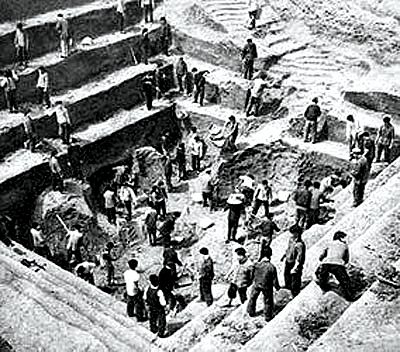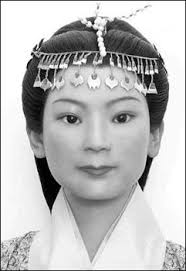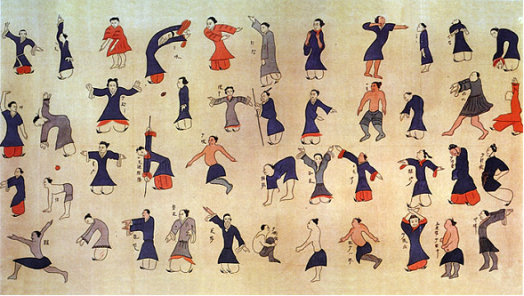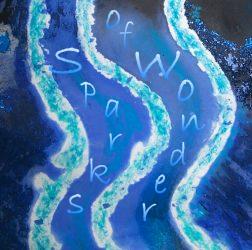
The Qigong form called Mawangdui Daoyin Shu (the Banner of King Ma’s Mound) was discovered in 1971, in the Chinese region of Hunan, near the city of Changsha, in one of three extraordinarily well-preserved tombs dating back to 168 b.C. As it often happens in archaeology, these graves were discovered by accident: digging the earth to build an underground wharehouse, some workers discovered a thick layer of white clay. When they tried to pierce through this layer, a gust of gaz came suddenly out and even caught fire, as one of the workers had lit a cigarette. We are lucky that this incident did not destroy the whole archaeological site… a wonderful piece of history would have been lost for ever. The presence of wisps indicated that there could be a tomb there; moreover, old legends narrated that some noble people had been buried in that area. The archaeological excavation started. (1)


The first of the three tombs was dug in 1973; under the first layer of white clay and charcoal, archaeologists found a huge 7m x 5m x 3m sarcophagus made of bamboo, which immediately blackened on contact with air. The sarcophagus contained four coffins nested inside each other and sealed with precious laquer. The last coffin held the body of a woman immersed in some liquid substance. Her face and skin were fresh, her flesh still soft, her inner organs in an incredible state of preservation. The autopsy revealed that she was slighty overweight and that her dietary habits were not very balanced, as she preferred meat and sweets. She was in her late 50s when she died, probably from a heart attack after suffocating, owing to a big bite of some kind of watermelon (dozens of seeds were found in her stomach!). In fact, she was very fit for her age and for the time she was living in. For sure, she was a sweet tooth, but she was also a cultured and extraordinary woman.



She was buried with an incredible quantity of food – probably what she liked most, such as cereal soups, jujubes, rice, lotus flower soups, skewers, whole roasted animals (even a swan!). A silk inscription allowed us to know her name: Xīnzhuī 辛追”, Marquise and wife of Lìcāng 利蒼, Prime Minister of the Kingdom of Chángshā. She was buried in the second century before our era, that is at the beginning of the Han dynasty. The remaining two graves contained the bodies of her husband and one of their sons, respectively. Xīnzhuī‘s high rank and luxurius lifestyle are revealed by the presence of over three-thousand precious artifacts in her grave: cosmetic products, fine laquered objects, sumptous silk dresses, musical instruments, paintings, furniture… The depth of her knowledge is witnessed by hundreds of priceless manuscripts (a total of more that 23,000 readable ideograms in silk rolls, about medicine, philosopy, astronomy, only to name a few).

In her grave archaeologists also found a particular version of LaoZi’s Dao De Jing. But surely, the archaeological find I’m most thrilled about is the so-called Mawangdui Banner, i.e. a silk painting illustrating a series of bodily exercises that experts consider, so to say, being the ancestors of many current forms of Qìgōng and Taijichuan. And this is one of Qigong forms I prefer practicing and teaching.
The Banner, a 50cm x 150 cm (approximately) painted piece of silk, shows 4 rows of 11 figures, i.e. a total of 44 different postures and movements. This unprecedented archaeological find was first called Dao Yin Tu 導引圖 [Dao means to guide (Qi) and Yin means to pull (Meridians), and actually corresponds to an earlier name for current Qigong]. The painted figures represent a large sample of what Qigong practitioners still do nowadays: breathing techniques and sounds, static and dynamic exercises, self-massages in different positions. The restored Banner is really beautiful and full of life!

Thanks to a painstaking work by a team of archaeologists, researchers and Qigong masters, the Banner has been restored and given back to practitioners all over the world. In this team, let me pay homage to Master Qiu Pi Xiang (a woman) and her disciple Wang Zhen. My teacher, Liao Yi Lin, told me Master Qiu Pi Xiang is a renowned Qigong master, while Wang Zhen is also a historian and a scholar. Liao Yi Lin, a wonderful teacher herself, learned the whole original form from both of them, including its therapeutic and historical aspects. Liao teaches in a lovely place in Paris, France. Thanks to Liao, I could bring this wonderful Qigong form to Italy, where I live and teach. As far as I know, Liao is the only teacher in Europe (along with her trained students) who transmits Mawangdui Qigong in its original and complete form, which was later replaced by the more widespread simplified form.

The 44 figures represented on the Banner seemingly have different ages; half of them are men, the other half are women (hear ye, hear ye!). From the clothes they wear we can presume they belong to a variety of social classes. Thus, we may say that the practice of this ancestor of our Qigong was open and transversal… Each of the figures has a caption containing the number/name of the exercise and/or its therapeutic function, referring to a written description of the movements. Some of the attached written descriptions were illegible, but archaelogists could rebuild the whole Banner by referring to other better-preserved manuscripts without illustrations, which were excavated at Zhangjiashan. Some of the descriptions of the well-known Yinshu (2) – The Pulling Book – found on this site do not quite correspond to the illustrations of Mawangdui with the same title, and this was an additional challenge for the scholars who rebuilt the text. Some of the names of the movements were therefore chosen by Qigong masters of our time, with the intention of transmitting this inestimable information without betraying the original spirit of the authors of the original text. Many exercises refer to animals: hawk, eagle, wolf, crane, bear, tortoise, and so on …
The Chinese Health Qigong Association later proposed a much enjoyable simplified form of Mawangdui Daoyin Shu, for a wider public. This form consists of 12 movements, that the same Master Qiu Pi Xiang extrapolated in order to work on the main 12 Meridians. I personally prefer the whole form that I learned from Master Qiu‘s disciple Liao Yi Lin, because it allows a more precise modulation of the movements according to the seasons and the practitioner’s health. Moreover, it naturally leads to profound meditative states. During one of her stages, Liao explained to us that the Chinese government now fortunately promotes Qigong again, acknowledging its efficiency in preventing disease, but the sad episode of the Falun Gong School still invite the authorities to a certain caution. Liao then added:
During the last twenty years I developed this practice, which also evolved into healing walks and specific movements for meditation, I tried to maintain the original spiritual essence – in the good sense – of this form as alive as possible. The Mawangdui form I teach is the result of a personal elaboration, and this is why I named it Liao Ch’an Qigong, in reference to the Chinese Ch’an Buddhism, from which blossomed the well-known Japanese Zen. (Liao Yi Lin)
Liao‘s profound and graceful teachings focus on the necessity to live fully in the body AND spirit, in harmony with the cycles of Nature: I love that!
The illustrated exercises we find on the original Banner can be subdivided into 5 main categories:
- Exercises imitating animal movements, with very poetic names such as The Crane opens its Wings, The Dragon stands up on its legs, The Eagle soars up, and so on. These imaginative names reveal the shamanic origin of Dao Yin and Qigong. (3)
- Exercises of limb and body elongation, whose name always starts with the term Yin 引 «pull» (4). As mentioned above, it is the second ideogram of Dao Yin 導引, the old name for Qigong, which in ancient classic texts is described as a particular category of movements whose aim is to consciously move the healthy vital energy Zheng Qi 正氣, with the help of specific breathing techniques and a focused mind, so to eliminate pathogenic energy (Xie Qi 邪氣) from the organism. The full interpretation given by the Chinese Health Qigong Association is the following: “guiding Qi to reach harmony, leading the body into a state of deep relaxation”.
- Exercises promoting Qi circulation with specific breathing techniques and the swallowing of saliva.
- Exercises increasing strength and stamina (kicking, archery, movements with the use of a bamboo stick…)
- Self-massages to relieve pain (in joints and back) and to reduce and heal the negative effects of adverse weather conditions (wind, humidity, cold, drought, heat).
Mawangdui excavations are a cornerstone in Chinese archaeology, because of the priceless objects and texts that were unearthed. Among them, there are 11 medical texts, respectively written on 3 silk rolls and 4 bamboo tablets, which are 3rd century B.C. copies of much earlier texts, probably dating back even before the Huángdì Nèijīng, which had long been considered the earliest classic text of TCM (Traditional Chinese Medicine). Mawangdui tombs also contain the oldest Chinese astronomical texts, such as Wŭxīng zhàn 五星占 (Observation of the Five Stars) and Tiānwén qìxiàng zázhàn 天文气象雜占 (Climate and Astronomical Observations).
An interesting data is that in Mawangdui texts there are no references to the use of needles for acupunture, but only to the use of moxa [5]. The term which is now in use for the Meridians, Jing Luo, i.e. ‘warp and weft” is absent; instead, the authors of the texts use the word Wēn 温 [6], “warmth”. Dr Giulia Boschi, a prominent Italian sinologist and Qigong teacher and researcher, gives the following explanation in her book Medicina Cinese: la Radice e i Fiori (Chinese Medicine: the Root and the Flowers) (one of my favourite books ever!):
The flow of Qi was thus perceived as warmth moving in linear pathways, like channels, and this explains the use of moxa when this flow was seemingly obstructed. (Giulia Boschi)
According to Dr Boschi, the refined theory of Meridians and the flow of Qi did not originate
from a therapeutic background, but rather in the context of techniques for longevity, closely related to Dao Yin-Qi Gong exercises and dietetics. (Giulia Boschi)
In other words, through the movements illustrated in Mawangdui Banner and other exercises, from time immemorial the practitioners have felt some “lines” of warmth in their bodies; these subjective perceptions of well-being subsequently gave rise to the energetic mapping we still use today in TCM. When the “warmth” cannot flow anymore, it is a first alarm: we know we have to do something (Qigong, an appropriate diet, acupuncture, herbs…) to recover the normal Qi flow.

As a conclusion, we can say that Mawangdui Banner is one of the most refined examples of the continuity and coherence of the therapeutic techniques we sum up under the name of Qigong. The whole sequence of Mawangdui Qigong form, as transmitted by Liao Yi Lin, certainly belongs to the family of medical and spiritual Qigong. Important scientific studies have been carried out to prove its therapeutic efficiency (7).
I really invite you to read Liao Yi Lin’s book on Mawangdui Banner Qigong , and also to join her workshops at Montreuil, Paris. But if you come to Umbria, Italy, I will be very happy to share this simple, yet magical Qigong form with you!
(1) On Youtube you can find a 50 minutes documentary in English, issued by World Documentary Channel. This film recreates the historical environment of the Marquise, who lived during the Han dynasty. Scholars and scientists are still puzzled by the embalming techniques used to preserve her body. More specifically, the liquid she was immerged in, after being analyzed, showed the presence of many different substances. Among them, cinnabar (a red mineral from which mercury is extracted, widely used by alchemists), salt and magnesium. The Court of this lady was full of wise and knowledgeable people!
(2) Yinshu 引書, a manuscript on bamboo tablets of the Han dynasty, was discovered in 1984, eleven years after the discovery of Mawangdui site, on Zhang Jia Mountain 張家山 (Zhang Jia Shan), in Hubei province. According to the studies carried out by Peng Hao and Li Ling, Yinshu contains several treatises, divided into chapters, about health and logevity. The first section describes the hygiene rules necessary to preserve health, in harmony with the seasons. The second part describes 40 movements and bodily techniques to heal ailments – like in Mawangdui Banner – and 24 movements to prevent illnesses. The last section deals with breathing techniques.
(3) The idea of a healing ritual dance performed by a shaman is still recognizable in the similarities between the ideogram wǔ (舞 dance) and wū (巫 shaman). The pictogram that has been found on tortoise shells (which were used for divination) is ![]() : the upper part shows a person dancing with open arms; the sleeves or arms are decorated with strings or feathers. This is the wū or shaman. Underneath, the two smaller symbols 止 depict the dancing feet.
: the upper part shows a person dancing with open arms; the sleeves or arms are decorated with strings or feathers. This is the wū or shaman. Underneath, the two smaller symbols 止 depict the dancing feet.
(4) The ideogram consists of 弓 «bow» and 丨«string», suggesting the action of pulling.
(5) Moxibustion (or Moxa) is a healing technique belonging to TCM, consisting of the application of a burning “cigar” of dried mugwort (Artemisia Vulgaris) over particular acupuncture points.
(6) Wēn 温, “warmth” is composed by the root氵= 水 “water” + the phonetic ideogram 昷, “benevolence”, itself composed of “bowl” 皿 and “mouth” 曰. The original pictogram also included 囚 “inside”, meaning “prisoner”. The earlier ideogram thus suggests the idea of “feeding a prisoner” to illustrate a feeling of warmth and well-being.
(7) Here is a list of some experimental clinical studies on Mawangdui Qigong applied to several health issues:
– Experimental Study on Emotional Influences of Mawangdui Guided Exercises over Middle and Old-Aged Women by LIU Xianping, WANG Zhen, ZHOU Guangrui, 2010;
– On The Experimental Study Of Applying Gymnastic Qigong Of Mawangdui Guidance To Improve The Life Quality Of Patients With Hypertension by Na Liu & Kun Liu.
Moreover, there is a wide scientific litterature on the therapeutic effects of a variety of other Qigong forms, which is constantly updated. The largest database belongs to the Qigong Institute: http://www.qigonginstitute.org/html/papers.php.



One Reply to “”